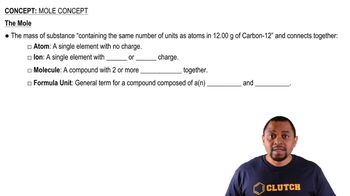Consider the reaction: 2 N2O( g) → 2 N2(g) + O2(g) a. Express the rate of the reaction in terms of the change in concentration of each of the reactants and products.
Ch.15 - Chemical Kinetics
Chapter 15, Problem 31
Is this the correct formulation for the task of completing the table for the reaction: Cl2(g) + 3 F2(g) → 2 ClF3(g)?
 Verified step by step guidance
Verified step by step guidance1
Identify the type of chemical reaction. This is a synthesis reaction where chlorine gas (Cl2) and fluorine gas (F2) react to form chlorine trifluoride (ClF3).
Write the balanced chemical equation: Cl2(g) + 3 F2(g) → 2 ClF3(g). This equation is already balanced, meaning the number of each type of atom is the same on both sides of the equation.
Determine the stoichiometric coefficients from the balanced equation: 1 mole of Cl2 reacts with 3 moles of F2 to produce 2 moles of ClF3.
Use the stoichiometric coefficients to complete the table. For example, if you know the amount of Cl2 used, you can calculate the amount of F2 needed and the amount of ClF3 produced using the mole ratios.
Ensure that all units are consistent when performing calculations, and convert between moles, grams, or liters as necessary using molar masses or ideal gas law if required.
Key Concepts
Here are the essential concepts you must grasp in order to answer the question correctly.
Stoichiometry
Stoichiometry is the branch of chemistry that deals with the quantitative relationships between the reactants and products in a chemical reaction. It involves using balanced chemical equations to determine the amounts of substances consumed and produced. In the given reaction, the coefficients indicate that one mole of Cl2 reacts with three moles of F2 to produce two moles of ClF3, which is essential for completing any related tables.
Recommended video:
Guided course

Stoichiometry Concept
Balancing Chemical Equations
Balancing chemical equations is a fundamental skill in chemistry that ensures the law of conservation of mass is upheld. This means that the number of atoms of each element must be the same on both sides of the equation. The provided reaction is already balanced, with two chlorine atoms and six fluorine atoms on both sides, which is crucial for accurately completing any associated tasks or tables.
Recommended video:
Guided course

Balancing Chemical Equations
Mole Concept
The mole concept is a foundational principle in chemistry that relates the mass of a substance to the number of particles it contains. One mole of any substance contains Avogadro's number (approximately 6.022 x 10^23) of entities, whether they are atoms, molecules, or ions. Understanding this concept is vital for interpreting the quantities involved in the reaction and for completing the table accurately.
Recommended video:
Guided course

Mole Concept
Related Practice
Textbook Question
1
views
Textbook Question
For the reaction 2 A(g) + B(g) → 3 C(g), a. Determine the expression for the rate of the reaction in terms of the change in concentration of each of the reactants and products.
Textbook Question
For the reaction 2 A(gg) + B(g) → 3 C(g), b. when A is decreasing at a rate of 0.200 M/s, how fast is B decreasing? How fast is C increasing?
Textbook Question
Consider the reaction: 8 H2S(g) + 4 O2(g) → 8 H2O(g) + S8(g) Complete the table.
1
views
Textbook Question
Consider the reaction: C4H8( g) → 2 C2H4( g) The tabulated data were collected for the concentration of C2H4 as a function of time: a. What is the average rate of the reaction between 0 and 10 s? Between 40 and 50 s?
